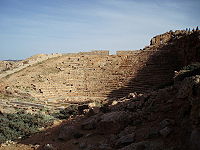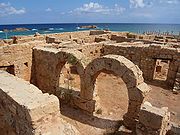
Apollonia, Cyrenaica
Encyclopedia



Greek language
Greek is an independent branch of the Indo-European family of languages. Native to the southern Balkans, it has the longest documented history of any Indo-European language, spanning 34 centuries of written records. Its writing system has been the Greek alphabet for the majority of its history;...
: Απολλωνία) in Cyrenaica
Cyrenaica
Cyrenaica is the eastern coastal region of Libya.Also known as Pentapolis in antiquity, it was part of the Creta et Cyrenaica province during the Roman period, later divided in Libia Pentapolis and Libia Sicca...
(modern Libya
Libya
Libya is an African country in the Maghreb region of North Africa bordered by the Mediterranean Sea to the north, Egypt to the east, Sudan to the southeast, Chad and Niger to the south, and Algeria and Tunisia to the west....
) was founded by Greek colonists and became a significant commercial centre in the southern Mediterranean. It served as the harbour of Cyrene
Cyrene, Libya
Cyrene was an ancient Greek colony and then a Roman city in present-day Shahhat, Libya, the oldest and most important of the five Greek cities in the region. It gave eastern Libya the classical name Cyrenaica that it has retained to modern times.Cyrene lies in a lush valley in the Jebel Akhdar...
, 20 km (12 mi) (12 miles) to the southwest. The Greek geographer and mathematician Eratosthenes
Eratosthenes
Eratosthenes of Cyrene was a Greek mathematician, poet, athlete, geographer, astronomer, and music theorist.He was the first person to use the word "geography" and invented the discipline of geography as we understand it...
was born there.
Apollonia was one of the five towns of the Libyan Pentapolis.
Ruins
The ruins of Apollonia are sited by the modern town of SusaSusa, Libya
Susa or Soussa is a town and seaside resort in the District of Jabal al Akhdar in north-eastern Libya. Susa stands by the ruins of Apollonia, Cyrenaica.The town contains the Apollonia Museum. It is located about 30 km northeast of Bayda....
. The Apollonia (Susa) Museum houses many artifacts found on the ancient site, Appolonia appears to have been hit by the tsunami caused by the Crete earthquake
365 Crete earthquake
The AD 365 Crete earthquake was an undersea earthquake that occurred at about sunrise on 21 July 365 in the Eastern Mediterranean, with an assumed epicentre near Crete. Geologists today estimate the quake to have been 8 on the Richter Scale or higher, causing widespread destruction in central and...
of 21 July 365 AD.

